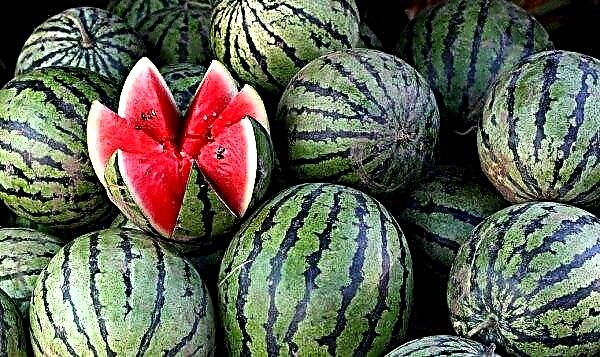Slender inflorescences of gladioli of the Priscilla variety, studded with bright lush flowers, can serve as a decoration for any flower bed. However, before planting them, it is necessary to study the description of the flower, its competent use in landscape design, the rules of planting and care.
Botanical grade description
Gladiolus (or fennel) Priscilla is a large-flowered hybrid variety bred in Holland. The diameter of the flower is 13-15 cm. The color is complex: the middle is white or creamy-orange, the edge is raspberry, connected to the main color by a pink transition, on the lower petals in the center there is a light yellow spot. The flower is accentuated by the squeezed edge of the petals and a velvety structure. The shape of the flower is funnel-shaped.
The stem of the plant with xiphoid leaves reaches a height of 105-120 cm. The spike-shaped inflorescence is 30–45 cm long. 20–27 buds are formed on it. Flowering lasts 30–35 days in July - September. The variety is unpretentious in care, however, it should be remembered that bulbs must be dug up for the winter.
Did you know? In ancient Greece, about 300 years BC. e., gladiolus was considered a harmful weed that interferes with the growth of wheat and other cereal crops, so the flowers found in the field were immediately pulled out together with corms and burned.
The use of flower in landscape design
Gladiolus Priscilla looks great both on its own and in group plantings on the flower beds. In mixed landings, it is better to place it on the second or subsequent plans. In the foreground, it is necessary to plant low perennial plants: hosts, geraniums, geyhera, or annuals: marigolds, snapdragons, alissum. Since the flowering is not long, then to gladioli it is necessary to select companions that bloom in other periods - then the flower bed will bloom throughout the season. Tulips and daffodils, irises and peonies, asters and chrysanthemums are well suited.
It should be remembered that gladiolus, especially such a colorful one, is not a background plant. Large flowers of the Priscilla variety are more suitable for a color and compositional accent. The background for them can serve as saturated greens of thuja, junipers and cypresses.
Important! The hue of the flowers of one kind of gladiolus depends on the type of soil on which it grows. This must be considered when color combinations in landscape design.
Group plantings of up to 8 bulbs are best done in the form of a circular spot. In this case, it is necessary to use bulbs of the same size and adhere to the landing step. Together with gladioli, it is not necessary to plant large plants that bloom in the same period - copies with openwork foliage are better.
It is not worth it to plant beds very tightly: you need to leave a little space around the stem so that you can take care of the flower and dig it up for the winter. Do not even plant a large number of bulbs with a symmetrical arrangement on the flowerbed. Such a monoclomb will lose decorativeness.
Flower planting
For planting gladiolus, sunny areas are better suited - in the shade, flowering will be weak or may be absent. The flower grows well on light, slightly acidic, drained soil. If the soil is dense, one of the disintegrants must be added to it: perlite, vermiculite, coarse sand, polystyrene or coconut fiber. Together with baking powder, organic fertilizers should be added to the soil at the rate of 4 liters of vermiculite per 10 kg of organic fertilizers.
Organic fertilizer application rates:
- compost 2–4 kg per 1 m²;
- manure 3-4 kg per 1 m²;
- bird droppings of 40–70 g per 1 m² (diluted in 10 parts of water).

Every year it is necessary to change the place of planting bulbs. This will serve as a good prevention against diseases.
Landing time
The planting of gladioli tubers must be carried out in spring, when the soil warms up to + 10 ° С. Depending on the weather and climatic conditions of the area, it is necessary to focus on the beginning of May. With late plantings, flowering will come later.
Did you know? In ancient Rome, magic power was attributed to the bulbs of gladiolus. They were worn by warriors around their neck like an amulet that protects against death and helps to win.
How to plant
Bulbs can be planted in rows, staggered, in groups. The distance between them should be at least 15–20 cm, between rows 25–30 cm. The planting depth depends on the size of the bulb and is equal to its three diameters. For a large onion, the recess is 15 cm.
 You can disinfect planting material with a weak solution of potassium permanganate, soaking it for 5 minutes.
You can disinfect planting material with a weak solution of potassium permanganate, soaking it for 5 minutes.
Before planting, the bulbs must be peeled, examined for defects, calibrated and treated with an antifungal drug according to the instructions. If there is more than one sprout on one tuber, leave a larger one.
Landing should be carried out at the following stages:
- Choose a place and method of landing.
- Dig holes to the required depth (see above).
- Mix the excavated soil with organic fertilizers and baking powder in the right proportions.
- Cover the bottom of the hole with a small layer of sand or vermiculite and moisten it.
- Spread planting material sprouts up.
- Fill the wells with prepared soil mixture.

Flower care
It is advisable to water the soil abundantly during flowering and in the dry period. Watering should not be carried out under the root, but at a distance of 10-15 cm. To prevent water from leaving, it is necessary to make small furrows in the aisles. Soil loosening should be carried out 3-4 times a season. Mulching the soil helps a lot in retaining moisture.
Important! Do not forget that during the flowering period, gladiolus must be tied up, otherwise they may bend to the ground. In circular landings, you can use one support for a group of colors.
If no nutrients were introduced into the soil during planting, then fertilizing with mineral fertilizers is mandatory. It plays an important role in the life and development of a flower. Spend it in several stages. When the first leaves appear, nitrogen fertilizers should be applied. After several green shoots have grown, fertilizers with phosphorus content must be applied. During the formation of the peduncle and after flowering, the plant needs potash and phosphorus fertilizers. They should be made in the form dissolved according to the instructions.
After flowering, by early October, the bulbs must be dug up and dried for a couple of weeks. Cut the stems, roots with a sharp knife and treat with fungicide. Dry and store until spring in a cardboard box in a cool place without freezing. In the apartment this can be done in the refrigerator. Tubers cannot winter in the soil.

In order for the gladiolus of Priscilla to please with beautiful flowers and decoratively look in the flowerbed, it is necessary to take into account the above tips. Trust your taste, do not be afraid to experiment, take into account the advice of flower growers and landscape designers - and the result will not keep you waiting long. The creative process will end with luxurious flowering in your flower beds.












